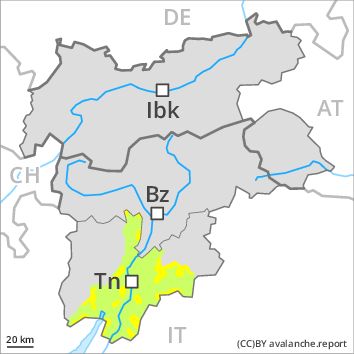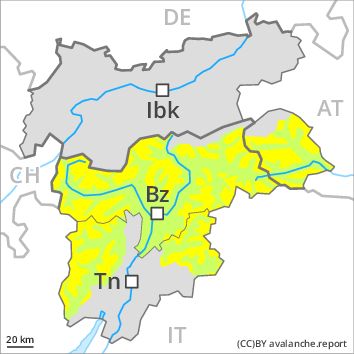Regions
Prealps, Cembra Valley, Bondone and Stivo, Vallarsa, Western Nonsberg Alps, Folgaria - Laverone, Southern Lagorai, Ledro Valley, Paganella, Marzola - Valsugana, Pine' - Mocheni Valley

Danger level
Danger Level 2 - Moderate above the treeline
Danger Level 1 - Low above the treeline
Avalanche Problem
Wind-drifted snow above the treeline, N-NE-E-SE-S-SW-W-NW
Wet snow above the treeline, E-SE-S-SW-W

Wind slabs require caution.
As a consequence of a sometimes strong wind from northwesterly directions, clearly visible wind slabs formed on Saturday. These can be released by a single winter sport participant in isolated cases at high altitudes and in high Alpine regions. The avalanche prone locations are to be found in particular on very steep shady slopes above approximately 2200 m and adjacent to ridgelines. In some cases the avalanches are medium-sized. At high altitudes and in high Alpine regions the avalanche prone locations are more prevalent and larger.
In addition as the day progresses some mostly small loose snow avalanches are possible. On sunny slopes the avalanche prone locations are more prevalent. Apart from the danger of being buried, restraint should be exercised as well in view of the danger of avalanches sweeping people along and giving rise to falls. Ski touring and other off-piste activities, including snowshoe hiking, call for extensive experience in the assessment of avalanche danger and careful route selection.
Snowpack
dp 6: cold, loose snow and wind
In some places fresh snow and wind slabs are lying on old snow containing large grains. This applies in particular on shady slopes at high altitudes and in high Alpine regions. The old snowpack will be subject to considerable local variations at low and intermediate altitudes. The surface of the snowpack will freeze, but a strong crust will not form and will soften during the day, in particular on steep sunny slopes as well as at low and intermediate altitudes.
Tendency
Hardly any increase in avalanche danger as a consequence of the fresh snow.
Regions
Sexten Dolomites, Latemar, Val Müstair Alps, Langtaufers, Schnals Ridge, Southern Stubai Alps, Saldurn-Mastaun Ridge, Southern Adamello, Texel Mountains, Adamello - Presanella, Sarntal Alps, Northern Brenta - Peller, Western Pfunderer Mountains, Southern Brenta, Northern Lagorai, Maddalene, Eastern Pfunderer Mountains, Durreck Range, Western Rieserferner Mountains, Western Deferegger Alps, Ortler Range, Ulten Valley, Eastern Nonsberger Alps, Eastern Rieserferner Mountains, Northern Dolomites of Fiemme, Primiero - Pale di S. Martino, Glockner Range, Gröden Dolomites, Eastern Deferegger Alps, Prags Dolomites, Schober Mountains, Lienzer Dolomites, Fassa Valley, Sole, Pejo and Rabbi

Danger level
Danger Level 2 - Moderate above 2200m
Danger Level 1 - Low above 2200m
Avalanche Problem
Wind-drifted snow above 2200m, N-NE-E-SE-S-NW

Fresh wind slabs at high altitude. On extremely steep slopes a large number of mostly small loose snow avalanches are to be expected.
As a consequence of a sometimes strong wind from northwesterly directions, mostly small wind slabs formed. These can be released by a single winter sport participant in isolated cases at high altitudes and in high Alpine regions. The avalanche prone locations are to be found in particular on very steep shady slopes and adjacent to ridgelines. Such avalanche prone locations are clearly recognisable to the trained eye. In some cases the avalanches are medium-sized.
As a consequence of warming during the day and solar radiation more frequent mostly small moist loose snow avalanches are to be expected. This applies in particular on extremely steep sunny slopes.
In highly frequented off-piste terrain and on popular backcountry touring routes the situation is more favourable.
Snowpack
dp 6: cold, loose snow and wind
dp 9: graupel blanketed with snow
The northwesterly wind has transported the fresh snow. In some places fresh snow and wind slabs are lying on soft layers, especially on shady slopes at high altitudes and in high Alpine regions. In very isolated cases weak layers exist in the old snowpack on shady slopes. The snowpack will become moist as the day progresses. This applies in particular on steep sunny slopes. At low and intermediate altitudes only a little snow is lying.
Tendency
The snow sport conditions outside marked and open pistes are generally favourable.


